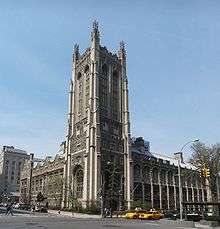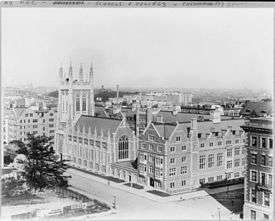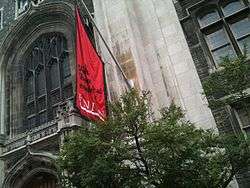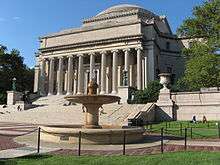Union Theological Seminary (New York City)
 | |
| Latin: Seminarium Theologici Unioniensis Novi Eboraci | |
| Motto | Unitas, Veritas, Caritas (Latin) |
|---|---|
Motto in English | Unity, Truth, Love |
| Type | Private |
| Established | 1836 |
| Endowment | US$108,000,000 |
| President | Serene Jones |
Academic staff | 38 |
| Students | 300 |
| Address | 3041 Broadway, New York, NY 10027, New York City (Morningside Heights, Manhattan), New York, USA |
| Affiliations | Columbia University |
| Website | www.utsnyc.edu |
|
Union Theological Seminary | |
   | |
| Location | W. 120th St. and Broadway, New York, NY 10027 |
| Coordinates | Coordinates: 40°48′41″N 73°57′51″W / 40.81139°N 73.96417°W |
| Area | 2.3 acres (0.93 ha) |
| Built | 1908 |
| Architect | Allen & Collens |
| Architectural style | Late Gothic Revival, Collegiate Gothic, Other |
| NRHP Reference # | 80002725[1] |
| Added to NRHP | April 23, 1980 |

Union Theological Seminary in the City of New York is an independent, ecumenical, Christian seminary. It is the oldest independent seminary in the United States. It was founded in 1836 by members of the Presbyterian Church in the U.S.A.,[2] but was open to students of all denominations. In 1893, Union rescinded the right of the General Assembly of the Presbyterian Church to veto faculty appointments, thus becoming fully independent. In the 20th century, Union was a center of liberal Christianity and neo-orthodoxy, in addition to being the birthplace of the Black theology, Womanist Theology, and other theological movements.
Union is affiliated with neighboring Columbia University and the seminary serves as Columbia's constituent faculty of theology, a status it has held since 1928. Union, although independent, is represented in Columbia's governance structure and appoints one faculty member and one student to be senators in the Columbia University Senate. In 1964, Union established an affiliation with neighboring Jewish Theological Seminary. Union houses the Columbia University Burke Library, one of the largest theological libraries in the Western Hemisphere.[3]
Campus

Union's campus is located in the Morningside Heights neighborhood of the New York City borough of Manhattan, bordered by Claremont Avenue, Broadway, 120th Street, and 122nd Street. The brick and limestone English Gothic revival architecture, by Francis R. Allen (1844–1931) and Collins, completed in 1910, includes the tower (pictured), which adapts features of the crossing tower of Durham Cathedral. Adjacent to Teachers College, Barnard College, the Jewish Theological Seminary of America, and the Manhattan School of Music, Union has cross-registration and library access agreements with all of these schools.
The building was added to the National Register of Historic Places on April 23, 1980. Some sections of the campus are now on long-term lease to Columbia University.
Union's urban campus is regarded by some to be among the most beautiful in the United States. The inner quadrangle and other various halls and rooms are often used as a filming location by the motion picture industry.
Library
The Burke Library, the largest theological library in the western hemisphere, contains holdings of over 700,000 items. The Library is recognized as one of the premier theological libraries in the world and includes extensive holdings of unique and special materials, including Greek census records from 20 CE, a rare 12th-century manuscript of the Life of St. Boniface, a 1520 imprint of Martin Luther’s first published writing, and one of the first African-American hymnals, published in Philadelphia in 1818.
The Burke Library offers a number of world-renowned archival collections, including the Archives of Women in Theological Scholarship and the Missionary Research Library Archives.
In 2004 Union's Burke Library became fully integrated into the Columbia University Library system, which holds over 10 million volumes. The library is named in honor of Walter Burke, a generous benefactor to the library who served as Chairman of the Board of Directors of the Seminary from 1976 to 1982.
History
Union Theological Seminary (UTS) was founded in 1836. During the late-19th Century, it became one of the leading centers of liberal Christianity in the United States. In 1891, Charles A. Briggs, who was being installed as the chair of Biblical Studies, delivered an inaugural address in which he questioned the verbal inspiration of Scripture.[4] When the General Assembly of the Presbyterian Church in the U.S.A. vetoed Briggs' appointment and eventually deposed Briggs for heresy two years later, Union removed itself from denominational oversight.[5] In 1939 the Auburn Theological Seminary moved to its campus.[6]
Among its graduates were the historian of Christianity Arthur McGiffert; biblical scholar James Moffatt; Harry Emerson Fosdick, the pastor of Riverside Church who served as professor during his tenure there; and the Socialist leader Norman Thomas.

In 1895, members of the Union Theological Seminary Alumni Club founded Union Settlement Association, one of the oldest settlement houses in New York City. After visiting Toynbee Hall in London and inspired by the example of Hull House in Chicago, the alumni decided to create a settlement house in the area of Manhattan enclosed on the north and south by East 96th and 110th Streets and on the east and west by the East River and Central Park.
Known as East Harlem, it was a neighborhood filled with new tenements but devoid of any civic services. The ethos of the settlement house movement called for its workers to “settle” in such neighborhoods in order to learn first-hand the problems of the residents. “It seemed to us that, as early settlers, we had a chance to grow up with the community and affect its development,” wrote William Adams Brown, Theology Professor, Union Theological Society (1892–1930) and President, Union Settlement Association (1915–1919).[7]
Union Settlement still exists, providing community-based services and programs to support the immigrant and low-income residents of East Harlem. One of East Harlem’s largest social service agencies, Union Settlement reaches more than 13,000 people annually at 17 locations throughout East Harlem through a range of programs, including early childhood education, youth development, senior services, job training, the arts, adult education, nutrition, counseling, a farmers' market, community development, and neighborhood cultural events.
Reinhold Niebuhr and Paul Tillich made UTS the center of both liberal and neo-orthodox Protestantism in the post-War period. Prominent public intellectual Cornel West commenced a promising academic career at UTS in 1977. As liberalism lost ground to conservatism after the 1960s (while neo-orthodoxy dissipated) and thus declined in prestige, UTS ran into financial difficulties and shrank significantly because of a reduced student base.
Eventually, the school agreed to lease some of its buildings to Columbia University and to transfer ownership of and responsibility for the Burke Library to Columbia. These agreements helped stabilize the school's finances, which had been hobbled by increasing library costs and the need for substantial campus repairs.
On July 1, 2008, feminist theologian Serene Jones became Union's first female president in its 172-year history, succeeding Joseph C. Hough, Jr.[8]
According to Columbia Wiki, "Union has a distinguished history among graduate theological institutions. Its faculty has always ranked among the best in the world and has included such luminaries as Walter Rauschenbusch, Reinhold Niebuhr, Paul Tillich, Dietrich Bonhoeffer, James Cone, Cornel West, and others. Its students come from around the country and the world. The seminary is known for its progressive understanding of religion in general, and Progressive Christianity in particular, and has long been at the forefront of the great social movements in this nation's history."[9]
On June 10, 2014, Jones announced that the Seminary would be joining the movement to divest from the fossil fuels industry in protest at the damage the industry is causing to the environment.[10] The Seminary's $108 million endowment will no longer include any fossil fuel investments.
Faculty
In 1930, Dietrich Bonhoeffer was a Postgraduate Teaching Fellow at the seminary. He later returned in 1939 to be a member of the faculty and to escape Nazi harassment in Germany. He soon regretted his decision and decided that he had to return to Germany to resist the Nazis. He took the last ship from New York to Germany in late August 1939. Due to his secret involvement with the 20 July plot on Hitler's life, he was executed at the Flossenbürg concentration camp on 8 April 1945, only 15 days before the United States Army liberated the camp.
Both Reinhold Niebuhr and Paul Tillich taught at the seminary during the post-World War II period.
Dr. Serene Jones, the seminary's first female president, was inaugurated in November 2008. Dr. Joseph Hough, UTS' immediate past president, is a Christian Democratic Socialist. Henry Sloane Coffin was a past president. Civil Rights Activist Cornel West joined the faculty in July 2012. Dr. James Hal Cone is one of the founders of liberation theology and is active in the development of African-American theology.
Union has also been home to Womanist theologians such as Delores S. Williams. Dr. Gary Dorrien is a social ethicist. Dr. James A. Forbes, the former senior pastor of the adjacent Riverside Church, is an adjunct professor at the seminary and had been a full-time, chaired professor before accepting the Riverside post.
Notable current faculty
- David M. Carr – Professor of Old Testament; contributed to Genesis in the New Oxford Annotated Bible (New Revised Standard Version)
- James Cone – Charles A. Briggs Distinguished Professor of Systematic Theology – Founder of Black theology
- Paul F. Knitter – Paul Tillich Professor of Theology
- Chung Hyun Kyung – Associate Professor of Ecumenical Theology
- Christopher Morse – Dietrich Bonhoeffer Professor of Theology & Ethics
- Very Revd. Dr. John Anthony McGuckin – Nielsen Professor of Early and Byzantine Church History, President of the Sophia Institute, Archpriest of the Orthodox Church
- Ann Belford Ulanov – Christiane Brooks Johnson Memorial Professor of Psychiatry and Religion
- Cornel West – Professor of Religious Philosophy and Christian Practice
Several of Union's members also teach in the Religious Studies department at Columbia University, the Teachers College, Columbia University, New York Theological Seminary, and the Jewish Theological Seminary of America.
Former theologians and faculty
- Charles Butler (1802–97) – founder
- William Greenough Thayer Shedd — Professor of Sacred Literature (1863–1874) and of Systematic Theology (1874–1890)
- Charles Augustus Briggs – Professor of Hebrew and Cognate Languages (1874–1891) and of Biblical Theology (1891–1904); an important early leader of the Modernist movement
- Reinhold Niebuhr (1892–1971) – Professor of Applied Christianity – Christian social ethics, author of the influential The Nature and Destiny of Man (1941), and the Serenity Prayer (popularized through the Twelve-step program)
- Paul Tillich (1886–1965) – German-American theologian and Christian existentialist philosopher
- James Hal Cone – Black theologian
- John Macquarrie – Professor of Systematic Theology (1962–70), afterwards Lady Margaret Professor of Divinity in the University of Oxford and Canon Residentiary of Christ Church, Oxford (1970–1986)
- Robert Pollack – professor of Science and Religion
- Raymond E. Brown (1928–1998) – Professor of New Testament (1971-1990), member of the Pontifical Bible Commission, and the first Catholic to gain tenure
- Edward Robinson – Biblical scholar and discoverer of Robinson's Arch and Hezekiah's Tunnel in Jerusalem
- Henry Sloane Coffin – President of Union and a leading theological liberal. Coffin also obtained his Bachelor of Divinity from the Union Theological Seminary in 1900. He declined an offer to become president of Union Theological Seminary in 1916. In 1926, offered the presidency (a second time), he accepted and retained the post until 1945.
- Dorothee Soelle – Socially engaged German theologian
- Harry Emerson Fosdick – First minister of Riverside Church and professor of homiletics
- Harry F. Ward – chairman of the ACLU and Professor of Ethics
- Walter Wink – Biblical scholar and activist
- Roger Haight – theologian banned from teaching by the Holy Office[11]
- Harrison S. Elliot (1882-1951) – author and leader in the Y.M.C.A., Religious Education Association, and Union Theological Seminary.
- J. Brooke Mosley, president
- W. D. Davies, (1911-2001), Welsh-born Edward Robinson Professor of Biblical Theology, noted New Testament scholar and Congregationalist Minister.
Notable alumni
- Rubem Alves – Brazilian theologian and writer
- William Scott Ament (Bachelor of Divinity, 1877) – controversial American missionary to China (1877–1909)
- John Batchelor – American radio news show writer and host
- Frederic Mayer Bird – Class of 1860: clergyman, educator, and hymnologist.
- J. Seelye Bixler – 16th president of Colby College
- Dietrich Bonhoeffer – German Lutheran theologian and Nazi resister who spent half a year at UTS. Of UTS he wrote: "There is no theology here....they talk a blue streak without the slightest substantive foundation and with no evidence of any criteria. The students....are completely clueless with respect to what dogmatics is really about. They are unfamiliar with even the most basic questions. They become intoxicated with liberal and humanistic phrases, laugh at the fundamentalists, and yet basically are not even up to their level." [12]
- Anton Boisen – founder of Clinical Pastoral Education (CPE) movement
- Marcus Borg – Biblical scholar and author; former Hundere Distinguished Professor of Religion and Culture at Oregon State University
- Malcolm Boyd – Episcopal priest and author. He was one of the most prominent of the gay clergy to come out of the closet when he did so in 1977. For two years in 1956 and 1957, Boyd engaged in post-graduate studies at Union Theological Seminary where he wrote his first book, Crisis in Communication. He participated in the civil rights and anti-Vietnam War movements in the 1960s.
- Frederick Buechner – writer
- Frederick Buckley Newell (Bachelor of Divinity, 1916) – Bishop of The Methodist Church
- Edwin Otway Burnham (Bachelor of Divinity, 1855) – a rifle shooting Presbyterian missionary in Sioux Indian territory who could bark a squirrel, swing an axe or dispense Gospel with equal fervor and efficiency.
- Walter Brueggemann – William Marcellus McPheeters professor of Old Testament at Columbia Theological Seminary
- Gladwyn M. Childs – anthropologist and missionary
- Nelson Cruikshank (Master of divinity, 1929) – labor union activist and strategist responsible for the passage of Medicare
- David Dellinger – noted American peace activist and member of the Chicago Seven
- Lynn de Silva (Master of Sacred Theology) – Sri Lankan theologian, former director of the Ecumenical Institute for Study and Dialogue, Methodist minister, and a pioneer in promoting Buddhist–Christian dialogue
- Helen Flanders Dunbar (B.D. 1927) – an important early figure in U.S. psychosomatic medicine
- Franklin I. Gamwell – Shailer Mathews Professor of Religious Ethics, the Philosophy of Religion, and Theology at the Divinity School of the University of Chicago
- Francis L. Garrett – Chief of Chaplains of the U.S. Navy
- Susan E. Goff, suffragan bishop of the Episcopal Diocese of Virginia
- David P. Gushee – Distinguished University Professor of Christian Ethics at Mercer University. Author of 9 books and over 70 articles[13]
- Mark Hanson – former Presiding Bishop of the Evangelical Lutheran Church in America.
- Richard Holloway – Scottish writer and broadcaster and was formerly Bishop of Edinburgh
- Dwight Hopkins – Professor of Theology at the Divinity School at the University of Chicago
- Myles Horton – co-founder of the Highlander Center
- William H. Hudnut III – former Mayor of Indianapolis, Indiana (1976–1992)
- Ada Maria Isasi-Diaz – Professor of Ethics and Theology at Drew University
- Suzan Johnson Cook – former presidential advisor and United States Ambassador-at-Large for International Religious Freedom (2011–2013)
- Mark Juergensmeyer – Professor of Sociology, Religious Studies, and Global Studies at the University of California at Santa Barbara and Director of the Orfalea Center for Global and International Studies
- Norman J. Kansfield – President New Brunswick Theological Seminary 1993–2005 and Senior Scholar in Residence, Theological School, Drew University
- James Franklin Kay – Professor of Homiletics and Liturgics at Princeton Theological Seminary
- George R. Lunn - Mayor of Schenectady, New York, Member of the United States House of Representatives, Lieutenant Governor of New York
- Rollo May – Existential psychologist
- Rachel Kollock McDowell – religion editor of the New York Times (1920-1948)
- Andrew McLellan – former Moderator of the General Assembly of the Church of Scotland
- Bruce McLeod (PhD) – Moderator of the United Church of Canada
- William P. Merrill – first president on the Church Peace Union, writer of "Rise Up, O Men of God"
- Henry F. C. Nichols – member of the Wisconsin State Assembly
- Paul Raushenbush – American Baptist minister and Religion Editor for The Huffington Post
- John Bunyan Reeve - First black student, organized theology department at Howard University
- Scott Rennie – minister of the Church of Scotland at Queen's Cross Church, Aberdeen
- James Herman Robinson (1938) – founder of Operation Crossroads Africa, a forerunner of the Peace Corps
- Carl Rogers – pioneering psychologist
- E.P. Sanders – a principal founder of the New Perspective on Paul movement
- Nathan A. Scott, Jr. – scholar of religion and literature
- Henry Sloane Coffin – President of Union Theological Seminary
- Andrea Smith – Cherokee intellectual and anti-violence activist
- John Sung – a Chinese Christian evangelist who played an instrumental role in the revival movement among the Chinese in Mainland China, Taiwan, and Southeast Asia during the 1920s and 1930s
- John Stoltenberg – feminist writer
- Norman Thomas – American socialist
- K. H. Ting – President emeritus of the Three-Self Patriotic Movement and China Christian Council
- George W. Webber (1920–2010) – President of the New York Theological Seminary[14]
- Floyd Wilcox – third president of Shimer College
- Walter Wink – Biblical scholar and activist
- Juhanon Mar Thoma – Metropolitan of Marthoma Syrian Church in India
- Beverly Roberts Gaventa – New Testament exegete, theologian, and author most recently of When in Romans[15]
See also
References
- ↑ National Park Service (2010-07-09). "National Register Information System". National Register of Historic Places. National Park Service.
- ↑ Union Theological Seminary – Timeline, 1836 to 1869
- ↑ http://library.columbia.edu/locations/burke.html
- ↑ D.G. Hart & John Muether Seeking a Better Country: 300 Years of American Presbyterianism (Presbyterian & Reformed Publishing, 2007) pg. 183
- ↑ Hart & Muether, pg. 183
- ↑ "About Us". Auburn Theological Seminary web site. Retrieved 2010-01-21.
- ↑ A Teacher and His Times, William Adams Brown, Scribner, 1940.
- ↑ Union Theological Seminary – Serene Jones, President of the Faculty
- ↑ Columbia Wiki
- ↑ Serene Jones Divestment Announcement
- ↑ Commonweal article
- ↑ Metaxas, Eric| Bonhoeffer: Pastor, Martyr, Prophet, Spy 2010, Thomas Nelson Publishers, p. 101
- ↑ David P. Gushee's web site
- ↑ Martin, Douglas. "George W. Webber, Social Activist Minister, Dies at 90", The New York Times, July 12, 2010. Accessed July 13, 2010.
- ↑ Beverly Roberts Gaventa, When in Romans: An Invitation to Linger with the Gospel According to Paul, Grand Rapids: Baker Press. Description. Forthcoming, Nov. 15, 2016.
Bibliography
- Handy, Robert T. A History of Union Theological Seminary in New York. New York: Columbia University Press, 1987.
External links
| Wikimedia Commons has media related to Union Theological Seminary (New York City). |
- Union Theological Seminary webpage
- Union Podcast
- The WPA Guide to New York City 1939, reprint 1982.
- Union Theological Seminary in Columbia University's Wiki


